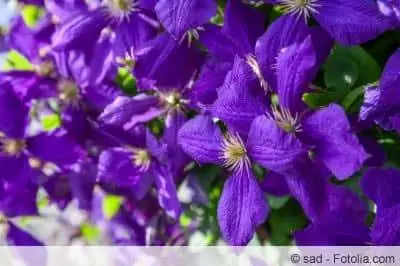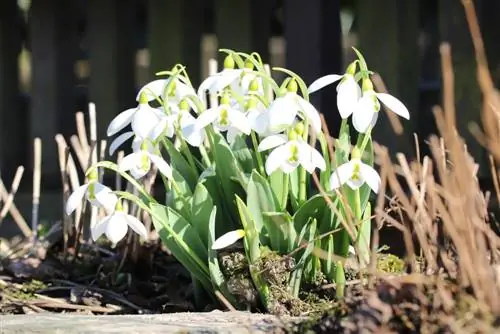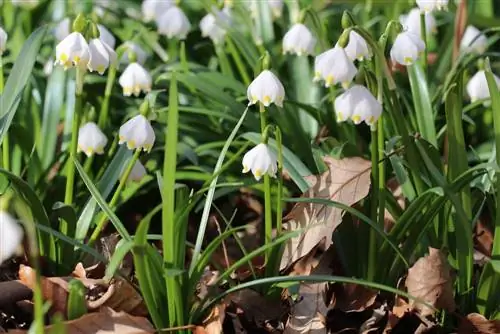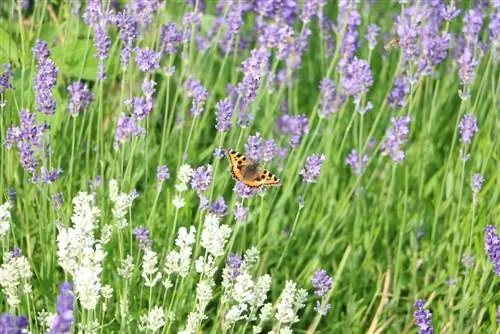- Author admin [email protected].
- Public 2023-12-17 03:39.
- Last modified 2025-01-24 12:45.
Which hobby gardener doesn't know the tall, colorful clematis. One of the easy-care and robust varieties is the Clematis Jackmanii, which, in contrast to its cultivated sisters, requires little care and is very resistant to diseases. If an unattractive house wall needs to be covered or a trellis needs to provide privacy to the neighboring property, then the fast-growing Clematis Jackmanii is a good choice. Because the dense foliage and the large, blue-violet flowers make every house wall a real eye-catcher.
Location
The Clematis Jackmanii primarily needs a climbing aid in its preferred location so that it can climb upwards. A trellis on a house wall or a free-standing pergola should be provided here. Otherwise, the decorative climbing plant places the following demands on its location:
- sunny to partially shaded
- avoid exposure to the hot midday sun
- where the root trunk needs shade
- As with all Clematis varieties, this one does not tolerate direct sunlight
- Ground cover plants can be planted around the trunk
- these provide the needed shade on the ground
Tip:
As an alternative to the ground cover used, mulch can also be added to the soil around the trunk. This is an option if the Clematis Jackmanii is to be planted as a solitaire.
Substrate & Soil

The Clematis Jackmanii prefers nutrient-rich and well-drained soil. This allows it to wonderfully develop its large, decorative flowers. Therefore, peat, sand and compost can be mixed into the soil at the location so that it maintains the conditions for the plant.
Watering & Fertilizing
The decorative plant needs to be watered and fertilized regularly. Care should be taken to ensure that the soil is always kept slightly moist, but waterlogging must be avoided at all costs. If the first shoots appear in the spring after frost, the first fertilizer application of the year should be started. Long-term fertilizer or liquid fertilizer for flowering plants is suitable for this and should be added according to the manufacturer's instructions. Alternatively, compost can be pulled underground in spring and again in summer. However, care must be taken to ensure that the roots are not damaged by digging.
Plants
The planting time for the decorative plant is spring, when the last night frosts have passed. A sufficiently large planting hole is then dug at the desired location. Since the Jackmanii, like all clematis varieties, does not tolerate waterlogging, drainage should be created at the bottom of the planting hole.
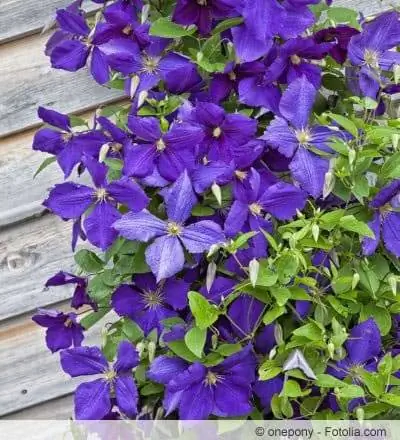
When planting, the ideal procedure is as follows:
- use pebbles, pottery shards or stones for drainage
- place these on the bottom of the planting hole
- Insert plant carefully
- the excavated earth was already placed in a wheelbarrow
- here you can prepare it better
- mix with sand, peat and compost
- fill carefully around the plant
- press lightly
- pour well
- Put mulch on the roots to protect them from the sun
- alternatively, dig small holes all around with your hands
- Use prepared ground cover plants here that provide shade
Cultivation in a bucket
The Jackmanii can also be cultivated in a pot at any time and given a sunny to partially shaded spot on a balcony or terrace. So no one has to do without the decorative vine, even if there is no garden. This clematis variety also feels at home in a pot and is easy to care for. Planting in the bucket should be carried out as follows:
- Use potting soil for potted plants
- create a drainage system to prevent waterlogging
- fill stones or shards of pottery over the drain hole
- there is plant fleece on top of that
- Fill half of the soil
- Insert plant
- Insert trellis directly
- fill up the remaining soil and press it down well
- water lightly
Tip:
In winter, despite the Jackmanii's good frost tolerance, the pot should be protected with plant fleece or jute mats. It is also helpful if the pot is placed on a Styrofoam plate or a wide wooden beam, so that no cold gets to the roots from below.
Repotting
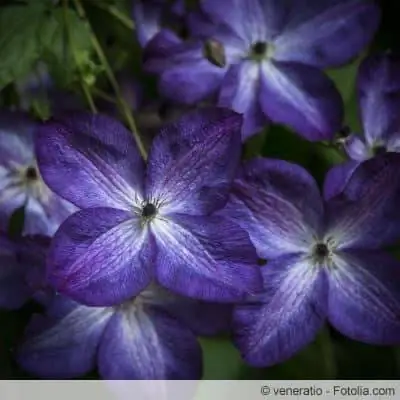
Frequent repotting is not necessary, but the plant can be moved to a new pot one size larger every two or three years. The procedure here is the same as when planting in a bucket.
Flowering time
The beautiful, decorative blue-violet flowers of the clematis variety Jackmanii reach a diameter of around 10 to 14 cm. During their peak flowering period, they form in large numbers and cover the entire leaves of the plant, which are then barely visible. The flowering period is throughout the summer from July to September and during this time offers a beautiful picture on a house wall, a pergola on a terrace or as a privacy screen from the neighbor.
Propagate
The Clematis Jackmanii is easily propagated by cuttings, which are obtained by so-called lowering, or by cuttings. Both procedures are relatively simple and usually successful. If cuttings are obtained, they are cut from the new shoots in early summer. To do this, cut shoots about five to eight centimeters long from the plant and place them in small pots with potting soil. Place them in a bright spot, avoid direct sunlight, and always keep the soil moist. Roots form after a short time. They can then be transplanted into larger pots for the time being and moved to a frost-free location over the winter before being transplanted to their final outdoor location next spring. When propagating using lowering plants, the procedure is as follows:
- Prepare the flower pot with potting soil
- dig into the ground next to the mother plant
- choose long shoot from the plant
- detach this from the climbing aid
- Pull it over the flower pot and carefully bend it at a knot
- a knot is a thickening
- press lightly into the ground
- A tent peg can be used here to attach it
- this bend must not damage the shoot
- the rest of the shoot can be tied to a stick
- If roots have formed, the shoot is separated from the mother plant
- This offshoot will also be planted out next spring
Cutting
The ideal time for pruning, which should be done every year, is the first time after frost, when the days are getting warmer again. During this time the Jackmanii also begins to produce new shoots and should therefore be cut shortly beforehand. When making a cut, proceed as follows:
- remove all diseased branches that have dried out over the winter
- remove all frozen branches
- if necessary, cut down to the root trunk
- new shoots immediately form here on warmer days
- the plant re-forms from below
- shorten the remaining branches to around 40 to 80 cm
Tip:
The plant should be given a radical pruning every five years to prevent it from going bald. So it can rejuvenate itself from time to time. This offers the advantage that strong, long shoots with large, decorative flowers can always be formed.
Wintering
The Clematis Jackmanii can overwinter in its chosen location. Even if the upper part with the branches and leaves dries out in winter and sometimes even freezes, this is no reason to worry. Because the roots don't mind frost; in spring, with the first warm temperatures, the plant sprouts again from the roots. Otherwise, after the winter, it will also sprout again from older, long branches that have not been harmed by a hard winter. To protect against frost or drying out in winter, mulch or leaves can be added to the soil around the roots.
Diseases or pests
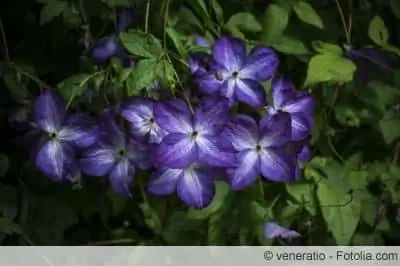
Care mistakes can actually hardly be made with the Clematis Jackmanii. If the right location has been chosen, almost nothing can be done wrong when it comes to care. But after a few years, the graceful plant no longer grows properly, hardly produces any at all, and if then only short and stunted shoots and only a few flowers, then it could be because it is bald. For the hobby gardener, this means that the plant needs a strong pruning, which is done directly above the root trunk. This means that the fast-growing Jackmanii can sprout again next spring and grow densely again and form a sea of flowers in the summer. Clematis wilt can be a serious disease. This fungal disease can attack the plant and cause serious damage. Therefore, the following should be noted:
- If the plant is infected, in the worst case it can die down to the root trunk
- Since it is a fungal disease, only fungicides help here
- if the plant and the soil around it have been treated, it can recover
- it will sprout again in the third year after the illness at the latest
Tip:
Fungal diseases on plants must always be taken seriously. Therefore, all affected plant parts must be widely removed and disposed of. Never add parts of the plant affected by a fungus, such as branches, stems or leaves, to the compost, as the disease can spread throughout the garden in this way. Always dispose of everything with household or residual waste.
Conclusion
The Clematis Jackmanii is a beautiful, decorative plant that can turn an undecorative house wall into a real eye-catcher. It can also be used as a privacy screen from neighbors or as a separation along a pergola between the terrace and the garden. Since this is one of the easy-care varieties of the diverse Clematis species, it requires little effort in care and is therefore also suitable for hobby gardeners with little time. It can also find a suitable place in the pot on the terrace or balcony.

